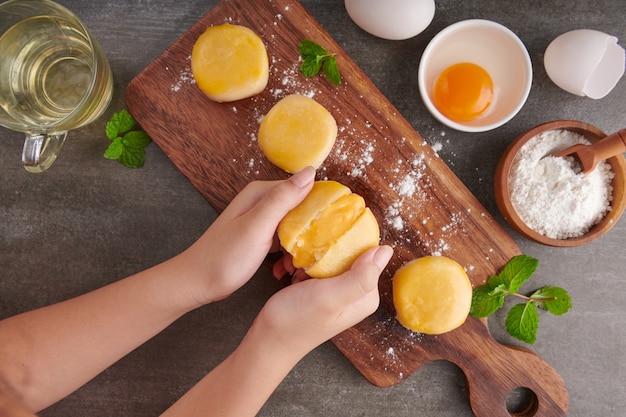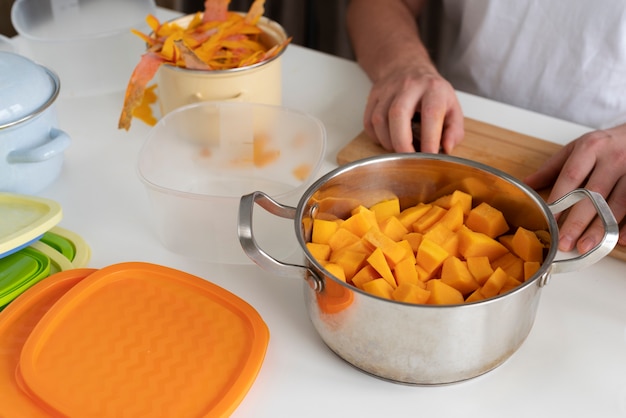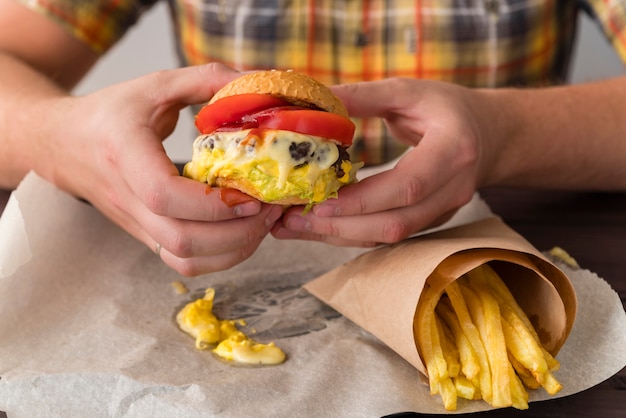Let's face it, we've all been there. You’re staring at a pot of potatoes, wishing they'd hurry up and get cooked. Maybe you've got a rumbling stomach, a hungry family, and a recipe that demands perfectly cooked spuds, but your patience is wearing thin. Don't worry, fellow potato lovers! There are ways to speed up the process and get those tatties on your plate in a flash.
From boiling to microwaving, pressure cooking to roasting, I'm going to spill the beans (or rather, the potato secrets!) on the quickest ways to get those spuds cooked to perfection. Get ready to ditch the slow-cook mentality and discover a whole new world of speedy potato cooking!
(Part 1) The Ultimate Speed-Cook Showdown: Boiling vs. Microwaving

Let's dive straight into the battle of the titans: boiling vs. microwaving. Both have their pros and cons, so it's all about choosing the right weapon for your culinary arsenal.
Boiling: The Classic Approach
Boiling is the classic method, and for good reason. It's simple, reliable, and doesn't require any fancy equipment. But let's face it, it can be a bit of a time suck.
How to Boil Potatoes for Maximum Speed
- Choose the right pot: A large, deep pot is crucial for boiling potatoes quickly. You want enough room for the potatoes to move around freely and cook evenly. A pot with a lid is also helpful, as it will help the water boil faster.
- Cut them right: Smaller potatoes cook faster, so don't be afraid to chop them up. I usually slice them into rounds or cubes, depending on the recipe. For smaller pieces, consider using a mandoline for consistent slices.
- Salted water is key: Adding salt to the boiling water not only seasons the potatoes but also helps them cook faster. The salt draws moisture out of the potatoes, speeding up the cooking process.
- Don't overcrowd the pot: Overcrowding the pot will slow down the cooking process, so leave some space between the potatoes. This allows the water to circulate freely and cook the potatoes evenly.
- Keep an eye on the temperature: The water needs to be boiling furiously for the potatoes to cook quickly. If it's simmering, it will take longer.
Now, here's where things get interesting. I've discovered a little trick that significantly reduces boiling time: cold water start.
Yes, you heard that right. I used to bring the water to a rolling boil before adding the potatoes, but then I realized that starting with cold water actually cuts down on the overall cooking time. Why? Because the potatoes are immersed in the water as it heats up, which means they start cooking earlier. It's a bit counterintuitive, but trust me, it works!
Microwaving: The Speedy Alternative
Microwaving is the ultimate speed demon when it comes to potato cooking. It's fast, efficient, and requires minimal effort. But be warned, it's not always the most predictable method.
The Art of microwaving potatoes: A Guide to Perfection
- The right potato: Microwaving works best with small potatoes. Large potatoes can be a bit tricky, as they might not cook evenly. Consider using baby potatoes or cutting larger potatoes into smaller pieces.
- Prick 'em good: Before you pop those potatoes in the microwave, be sure to prick them with a fork. This will help to release steam and prevent them from exploding in the microwave (been there, done that!).
- Cover them up: A good trick for even cooking is to cover the potatoes with a microwave-safe lid or plastic wrap. The steam helps to cook them more evenly. Be sure to vent the plastic wrap to avoid buildup of pressure.
- Don't overcook: Microwaving potatoes can be a bit of a guessing game. Start with short bursts of time (1-2 minutes), and check the potatoes for doneness. You don't want them to dry out or become mushy.
Boiling vs. Microwaving: The Verdict
Boiling is a tried-and-true method, but it can take a bit longer. Microwaving is the ultimate speed demon, but it might not be the most predictable method. Ultimately, the best method for you will depend on your personal preferences and the recipe you're making.
(Part 2) Beyond Boiling and Microwaving: Other Fast-Cooking Methods

Now that we've explored the classic speed-cooking contenders, let's expand our horizons and discover other ways to whip up potatoes in a hurry.
Pressure Cooking: The Power of Pressure
Pressure cooking is a game-changer when it comes to speed. It uses steam to cook food under pressure, which significantly reduces cooking time.
Mastering the pressure cooker for Speedy Potatoes
- Prepping is key: Cut your potatoes into small pieces or use baby potatoes for faster cooking.
- Add liquid: A little bit of water or broth is essential for pressure cooking. This helps create steam and ensure even cooking.
- Cook with caution: Pressure cookers can be dangerous if not used correctly. Always follow the manufacturer's instructions carefully.
- Release pressure carefully: After cooking, allow the pressure to release naturally for a few minutes before manually releasing the remaining pressure. This helps prevent splattering and ensures a more gentle release of steam.
Pressure cooking potatoes can be done in a fraction of the time it takes to boil them. For instance, a batch of baby potatoes can be cooked in under 5 minutes in a pressure cooker!
Roasting: Crisp and Golden Goodness
roasting potatoes is a fantastic way to achieve that crispy, golden-brown perfection. While it doesn't offer the same lightning-fast speed as other methods, it's still a relatively quick option, especially when compared to boiling.
Tips for Speed-Roasted Potatoes
- Smaller is better: Cut potatoes into smaller pieces to help them roast faster. This also allows for more surface area to get crispy.
- Preheating is key: Always preheat your oven to a high temperature (400°F or 200°C) before adding the potatoes. This will help them cook quickly and evenly.
- Toss them with oil: A good coating of oil will help to create a crispy crust. Use a neutral oil like canola or vegetable oil for best results.
- Don't overcrowd the pan: Give the potatoes some space to breathe, otherwise, they'll steam instead of roast.
- Use a baking sheet with a rack: Roasting potatoes on a baking sheet with a rack underneath helps them cook faster and more evenly. The air circulates better, and the potatoes don't sit in their own juices.
(Part 3) potato cooking time Chart: A Quick Reference Guide

Now, let's get down to the nitty-gritty: how long does it actually take to cook potatoes using these various methods? Here's a handy chart to give you a rough idea:
| Method | Size/Type | Cooking Time |
|---|---|---|
| Boiling | Small Potatoes | 10-15 minutes |
| Boiling | Medium Potatoes | 15-20 minutes |
| Boiling | Large Potatoes | 20-25 minutes |
| Microwaving | Small Potatoes | 5-8 minutes |
| Microwaving | Medium Potatoes | 8-12 minutes |
| Pressure Cooking | Small Potatoes | 3-5 minutes |
| Pressure Cooking | Medium Potatoes | 5-7 minutes |
| Roasting | Small Potatoes | 20-25 minutes |
| Roasting | Medium Potatoes | 25-30 minutes |
Remember, these are just estimated times. The actual cooking time may vary depending on the type of potato, the size, and the specific method you're using. It's always best to check the potatoes for doneness with a fork.
(Part 4) Don't Forget the Spud Accessories!
Now, let's talk about the essential tools that can make potato cooking a breeze.
Potato Masher: The MVP of mashed potatoes
A good potato masher is a must-have for any potato lover. It makes whipping up creamy, dreamy mashed potatoes a cinch.
I used to struggle with a flimsy handheld masher that felt like it was going to break with every push. Then I invested in a sturdy, heavy-duty masher, and it's been a lifesaver! A masher with a wide base provides more stability and control, making the mashing process much smoother.
Potato Ricer: For the Ultimate Smoothness
If you're after the smoothest mashed potatoes ever, a potato ricer is your best friend. It forces the cooked potatoes through a sieve, creating a light, fluffy texture that's simply irresistible.
I must admit, I'm a bit of a purist when it comes to mashed potatoes, and I love the silky smooth texture that a ricer produces. It also helps remove excess moisture, resulting in a lighter and more airy mashed potato.
Potato Peeler: Making Skinning a Breeze
A sharp potato peeler is essential for removing those pesky skins. It saves you time and prevents you from accidentally slicing off a fingertip (I've been there!).
I prefer a Y-shaped peeler. It's easy to grip and provides a good amount of control. Plus, it's much less likely to slip on your hand. You can also find peelers with different blade shapes, so experiment and find the one that works best for you.
(Part 5) Potato Cooking Hacks: The Insider's Tips
Ready to level up your potato-cooking game? Here are a few insider hacks that will save you time and energy:
Cold Water Start: Boiling Time Saver
We touched on this earlier, but it deserves its own spotlight. Starting with cold water when boiling potatoes actually helps them cook faster. The potatoes are immersed in the water as it heats up, which means they start cooking earlier.
Add a Pinch of Sugar: For sweet potatoes
When boiling sweet potatoes, add a pinch of sugar to the water. It helps to enhance their natural sweetness and create a more flavorful dish.
Keep Them from Browning: The Magic of Lemon Juice
Potatoes tend to brown quickly, especially when boiled. To prevent browning, add a squeeze of lemon juice to the water. The acid in the lemon juice helps to keep the potatoes bright and white. You can also try adding a splash of vinegar for a similar effect.
Steam to Perfection: A Speedy Alternative
Steaming is a great way to cook potatoes quickly and evenly. Simply place the potatoes in a steamer basket over boiling water and cover the pot. It takes about 10-15 minutes for small potatoes and 15-20 minutes for larger potatoes.
For steaming, use a steamer basket that fits snugly in your pot to prevent the potatoes from touching the boiling water. This ensures they cook evenly and prevent them from becoming soggy.
(Part 6) Potato Dishes that Scream "Fast and Delicious!"
Now, let's put those speedy potato-cooking skills to work! Here are a few quick and easy potato dishes that will satisfy your cravings in a flash:
1. potato salad with a Twist
This is a classic that's always a crowd-pleaser. You can whip it up in a matter of minutes, and there are endless possibilities for flavor combinations.
- Boil and Cube: Boil the potatoes until tender, then cube them. For a faster prep time, consider using a food processor with a grating attachment to cube the potatoes after boiling.
- Make the Dressing: Combine mayonnaise, mustard, vinegar, and seasonings to your liking. Use Dijon mustard for a tangy flavor or whole-grain mustard for a more robust taste.
- Toss and Chill: Toss the potatoes with the dressing and chill until ready to serve. For added flavor, you can toss in chopped herbs, chopped celery, red onion, or even a sprinkle of chopped bacon.
For a twist, add chopped celery, red onion, or fresh herbs. You can also experiment with different types of mayonnaise, like Dijon or horseradish, for a unique flavor profile.
2. Roasted Potatoes with Herbs
This simple dish is packed with flavor and takes only 20 minutes to cook.
- Prep the Potatoes: Cut the potatoes into small cubes and toss them with olive oil, salt, pepper, and your favorite herbs (rosemary, thyme, garlic, etc.). Use a generous amount of herbs to infuse the potatoes with a rich aroma and flavor.
- Roast to Perfection: Spread the potatoes on a baking sheet and roast in a preheated oven at 400°F (200°C) for 20-25 minutes, or until golden brown and tender.
You can add other vegetables to the mix, like onions, carrots, or bell peppers.
3. Crispy Potato Wedges with Garlic
These crispy wedges are irresistible! They're perfect as a side dish or a snack.
- Cut the Wedges: Cut potatoes into wedges and toss them with olive oil, salt, pepper, and garlic powder. For a crispy exterior, consider using a potato variety known for its high starch content, such as Russet or Idaho.
- Bake 'em Up: Bake the wedges in a preheated oven at 400°F (200°C) for 20-25 minutes, or until golden brown and crispy.
For a tangy twist, add a squeeze of lemon juice to the wedges before baking.
4. Pan-Fried Potatoes with Onions
This dish is perfect for a quick and flavorful side or a hearty breakfast.
- Dice and Fry: Dice the potatoes into small cubes and fry them in a skillet with a little oil over medium heat until they are golden brown and crispy.
- Add Onions: Add chopped onions to the skillet and cook until they are softened and slightly caramelized.
- Season and Serve: Season the potatoes and onions with salt, pepper, and your favorite herbs. Serve immediately.
You can add other vegetables to this dish, such as bell peppers, mushrooms, or spinach.
(Part 7) Potato Perfection: The Don'ts of Potato Cooking
Now, let's talk about the things you should never do when cooking potatoes.
1. Don't Overcook Them: A Mushy Mess
Overcooking potatoes can lead to a mushy texture that's less than appealing. Cook them until they're tender but still hold their shape. If you're unsure, it's always better to err on the side of undercooked. You can always cook them a little longer if needed.
2. Don't Forget to Prick: Microwave Mayhem
Always prick potatoes with a fork before microwaving them. This will allow steam to escape and prevent them from exploding in the microwave.
3. Don't Overcrowd the Pot: Uneven Cooking
Overcrowding the pot when boiling potatoes will slow down the cooking process and result in unevenly cooked potatoes. Give them some space to breathe.
4. Don't Skip the Salt: Flavor Booster
Salting the water when boiling potatoes is essential for both flavor and faster cooking. The salt helps to season the potatoes and also helps them to cook faster.
5. Don't Forget to Check for Doneness: The Fork Test
Always check the potatoes for doneness with a fork. If it slides in easily, they're ready. If it meets resistance, they need a little more time.
6. Don't Store Potatoes in the Refrigerator: Starchy Disasters
Potatoes are best stored in a cool, dark, and dry place. Refrigerating them can cause them to become starchy and develop an unpleasant taste.
(Part 8) FAQs: Your Potato-Cooking Questions Answered
Let's address some of the most common questions about potato cooking:
1. How do I know when potatoes are done?
The best way to test for doneness is with a fork. If it slides in easily, the potatoes are ready. If it meets resistance, they need a little more time. You can also check the potatoes by gently pressing on them. If they give slightly, they're done.
2. What are the best potatoes for boiling?
starchy potatoes, like Russet or Idaho, are ideal for boiling. They hold their shape well and are perfect for mashed potatoes, potato salad, and other dishes where you want a creamy texture.
3. What are the best potatoes for roasting?
waxy potatoes, like Yukon Gold or Red Bliss, are great for roasting. They have a firmer texture and won't become mushy during cooking. These potatoes also have a slightly sweet flavour, which complements roasting.
4. How do I store potatoes properly?
Store potatoes in a cool, dark, and dry place. Don't refrigerate them, as this can cause them to become starchy. Keep them in a well-ventilated container or basket, away from direct sunlight and heat.
5. Can I use leftover potatoes?
Yes, leftover potatoes can be used in a variety of dishes. Simply refrigerate them for up to 3 days. You can use them in salads, soups, stews, or even fry them up for a crispy treat.
6. What are some tips for getting crispy potatoes?
For crispy potatoes, use a high-starch potato variety, such as Russet or Idaho. Cut them into wedges or chunks and toss them with a good amount of oil, salt, and pepper. Bake them in a preheated oven at a high temperature until they are golden brown and crispy. You can also try pan-frying the potatoes for a crispy exterior.
7. What is the difference between boiling and steaming potatoes?
Boiling potatoes involves immersing them in boiling water, while steaming involves cooking them with steam. Steaming is generally considered a healthier method as it preserves more nutrients. Steaming also helps prevent the potatoes from becoming mushy and can be a faster option, as the potatoes cook more evenly.
Everyone is watching

How to Cook Frozen Lobster Tails Perfectly: A Step-by-Step Guide
RecipesLobster. Just the word conjures up images of lavish meals, special occasions, and a taste of luxury. But let's...

Pigs in a Blanket Cooking Time: How Long to Bake for Perfect Results
RecipesAh, pigs in a blanket. Just the name conjures up images of those delightful little parcels of crispy pastry en...

Pork Fillet Cooking Time: How Long to Cook It Perfectly
RecipesPork fillet, or tenderloin as it's sometimes called, is a real favourite in our house. It's so versatile, and...

The Ultimate Guide to Cooking Delicious Frankfurters
RecipesLet's face it, we all love a good frankfurter. It's a classic, simple, and always satisfying. But let's be rea...

Wolf Meat Recipes: A Guide to Cooking Wild Game
RecipesLet's be honest, you don't see wolf meat at your local butcher shop every day. It's a bit of a wild card, but ...
